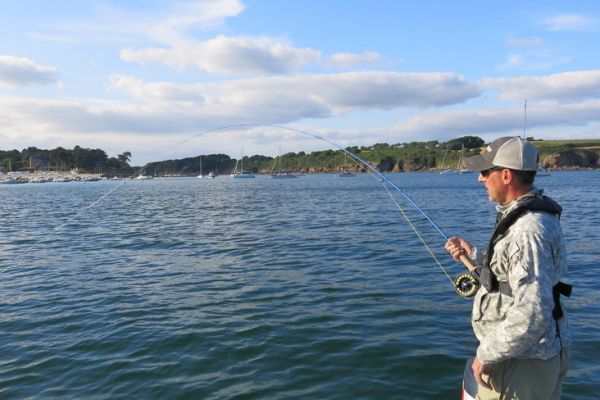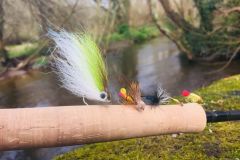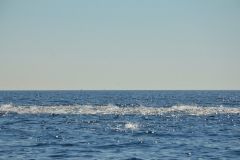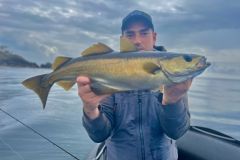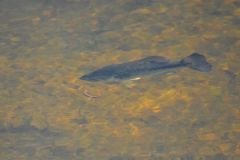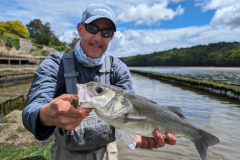Little equipment to get started
Sea bass and mullet are in permanent contact with each other, whether along coasts, beaches or estuaries, and even in the lower reaches of most coastal rivers. Whether sight fishing or prospecting, their fishing is very interesting and requires very little equipment to make your first catch. A rod, even a reservoir-type rod, will do the trick. Add a reel fitted with a floating line and a few flies and you're ready to take on these powerful, combative sport fish. They will bend the carbon of your rods and give you great sensations.
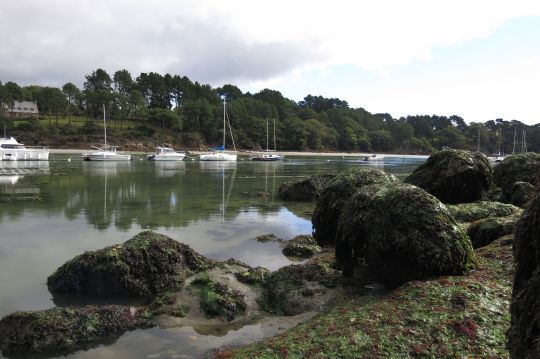
Sea bass fishing on the coast and in estuaries
Increasingly popular, fly-fishing for sea bass has made its mark.
We are fortunate that the sea bass lives in a vast array of environments, which means that it can be found in many French departments, but also offers a wide choice for those wishing to seek it out in a habitat that suits it: open seas, beaches, on the coast, on islands and in estuaries and rias. To make matters worse, it takes us to places where the scenery is often superb, in a wild, natural environment that's a change of scenery for us freshwater anglers.
Sea bass are super predators with a wide range of prey: mackerel, sardines, pollack, sand eels, sprats and other small forage fish, as well as worms, shrimps and crabs, are eaten daily by sea bass.
It's an exciting fish because of its highly varied diet and, consequently, its behavior. It is wary, cunning and highly opportunistic. It knows how to adapt perfectly to its environment, living just as well in the depths as it does snapping up crabs and shrimps with its back or tail out of the water!
Its fishing season runs from April to the end of November. For freshwater anglers, this considerably extends our season, but also diversifies our fishing.
Let's take a look at how to approach fishing for this species, depending on the environment in which you are likely to encounter it.
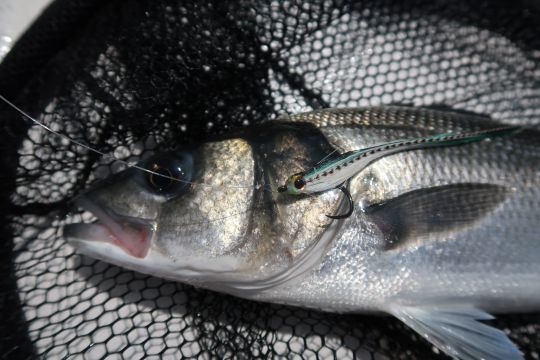
In the open sea :
If you can rent a kayak or paddle, or go out by boat, you can try sea bass in the open sea. Choose edges, points, rocky plateaus and currents. There's no point in going too far out and consuming fuel, as sea bass swim close to shore and often in very little water (less than 5 m). Look for seabirds and currents, and try to fish where the bottom changes. Sea bass love to camouflage themselves and stay on the edge of changing substrates (sand/seaweed, for example). Rocky points, bays, coves or areas with changing environments are always good spots.
An intermediate line is often more effective for keeping your fly in the right layer of water, drifting, finished with a 2.5-metre tippet at 25 to 30°. Once again, 10 to 15 cm streamers in tan, grey, white or olive-blue backs should bring you a few catches. Change flies regularly if you don't get a bite and to find the day's menu.
On the beach:
Not far from the bathers, the bars make the most of this hustle and bustle, attracting small fry. Early in the morning and in the evening, before or after a good day on the beach with the family, you can escape for a few hours and try a few bars.
It's not uncommon for them to hunt on beaches, especially in the surf very close to the shore. Floating silk imitations of small forage fish in the above-mentioned colors will enable you to catch marauding bass. Sea bass also feed on small flatfish, shrimp and gobies. They are sometimes very close to bathers. I've caught them from my boat within 5 meters of tourists enjoying the cool Breton waters.
Don't hesitate to try them out with small surface flies, especially at this time of day. A white gurgler in size 2 or 1/0 or a small popper could bring you a few surprises, and some great thrills!
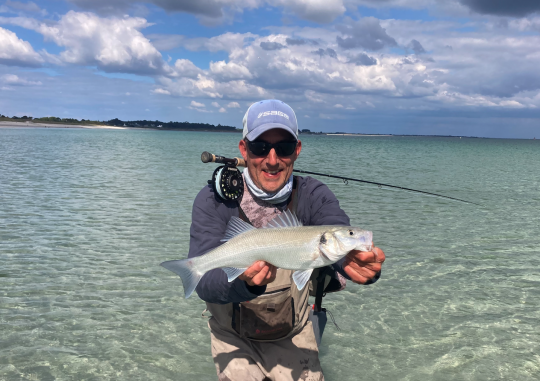
From shore to shore:
No matter where you are on the seafront, on the mainland or on an island, bars can be found just about everywhere, depending on the food available and the tides.
As with the boat, you need to observe the environment and look once again for currents, bays, rocky points and any areas of change (rock/sand, light/dark bottom, etc.) that betray a change in the bottom and environment.
Oyster beds are excellent spots for sea bass, so if there's one around, go for it!
If there's no touchdown, change spots regularly or tide times. Watch the locals and talk to them. From the shore, you're less mobile than from a boat and you have to fall in at the right moment of the tide. But sometimes, by staying on the same spot and modifying your line density, fly animation and color, you'll find the solution.
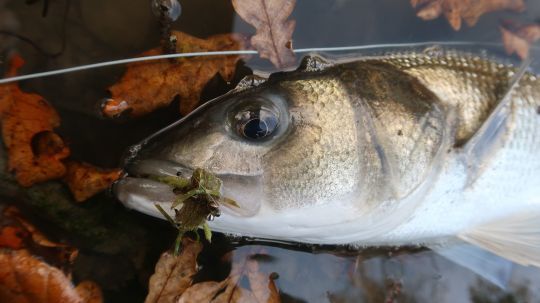
Fishing in estuaries :
Sea bass migrate up all estuaries and into freshwater to find their food. This extremely rich environment is both a nursery for juveniles and a home for very large, sedentary sea bass.
Streamer and surface fly fishing can be practised here as elsewhere. On the other hand, it is possible to sight-fish for bass in very little water when they come to eat crabs and shrimps on the edges. This allows you to select the size of the fish and get a big adrenalin rush! It's also the ultimate challenge. Choose wind-sheltered edges and keep your eyes open, because they're there, hiding behind a clump of seaweed or rocks, lying in wait!
In all cases, and regardless of the type of environment, you need to note the time of day when you caught, saw or touched fish. Sea bass have their own habits and frequently pass by at the same time, which does not correspond to the time of day, but to a certain height of water. Check the tide gauges. Coefficients vary constantly and influence currents. Some corners operate with small or large coefficients, others with almost no coefficients at all. But that's something you'll have to find out by making several trips.
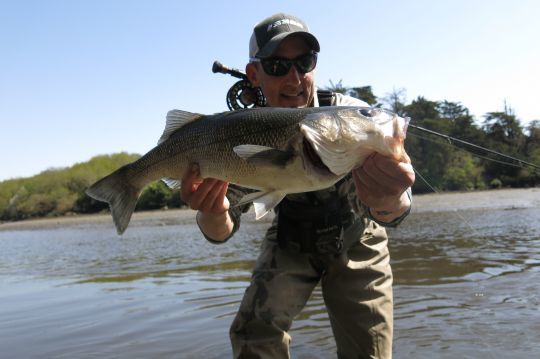
How do you pick up your first bars?
To get started, there's no point in complicating the task.
Take a 9 to 10 foot 7 or 8 line tank rod. A WF floating line, a leader without a knot or made with 3 or 4 fluorocarbon strands (decreasing in size and length), a rod and a half long, then a few streamers from 8 to 15 cm in size 4 to 1/0 in several colors. A casting basket is a great help to avoid damaging your silk and hooking up everywhere.
Try to go out with coefficients between 50 and 80 maximum. These are the most regular for sea bass.
Try different corners, but look for a place where you can switch from one type of environment to another quickly as described above. Reading the water is as important in the sea as it is in freshwater. Fish in a fan pattern in one spot for 20 to 30 minutes, then move to another spot. Freshwater inlets, bays and rocky points are often transit zones. If you have the opportunity to repeat several trips, fish at different tide times and observe when and how currents are created. Try to pass by your fishing spot at low tide with a coefficient of over 70 to see what structures and bottoms there are, areas of sea grass and algae, and rocks. This will give you additional information.
Look out for potential prey such as small fish, shrimps and crabs, and look carefully at your feet, as sea bass come in very little water. Conversely, look up to see if birds (especially terns and cormorants) are active and hunting too.
In the event of bites, don't strike too quickly. Sea bass often engulf their prey and the strike should be delayed and not too violent, more often with the silk before lifting the rod.
If you keep a sea bass (over 42 cm), empty its stomach to see what it has just ingested. Observe the size and color of the prey, which will help you on future outings.
Apart from sea bass, you can of course go for mullet, but it remains a rather complicated fish to catch, whatever the technique. By accident and when fishing in rocky areas, the old ones can come and take a streamer, as can the small ones. On jetties, in harbours and especially at night under lampposts, horse mackerel and pout will be added to the list of species to catch.

